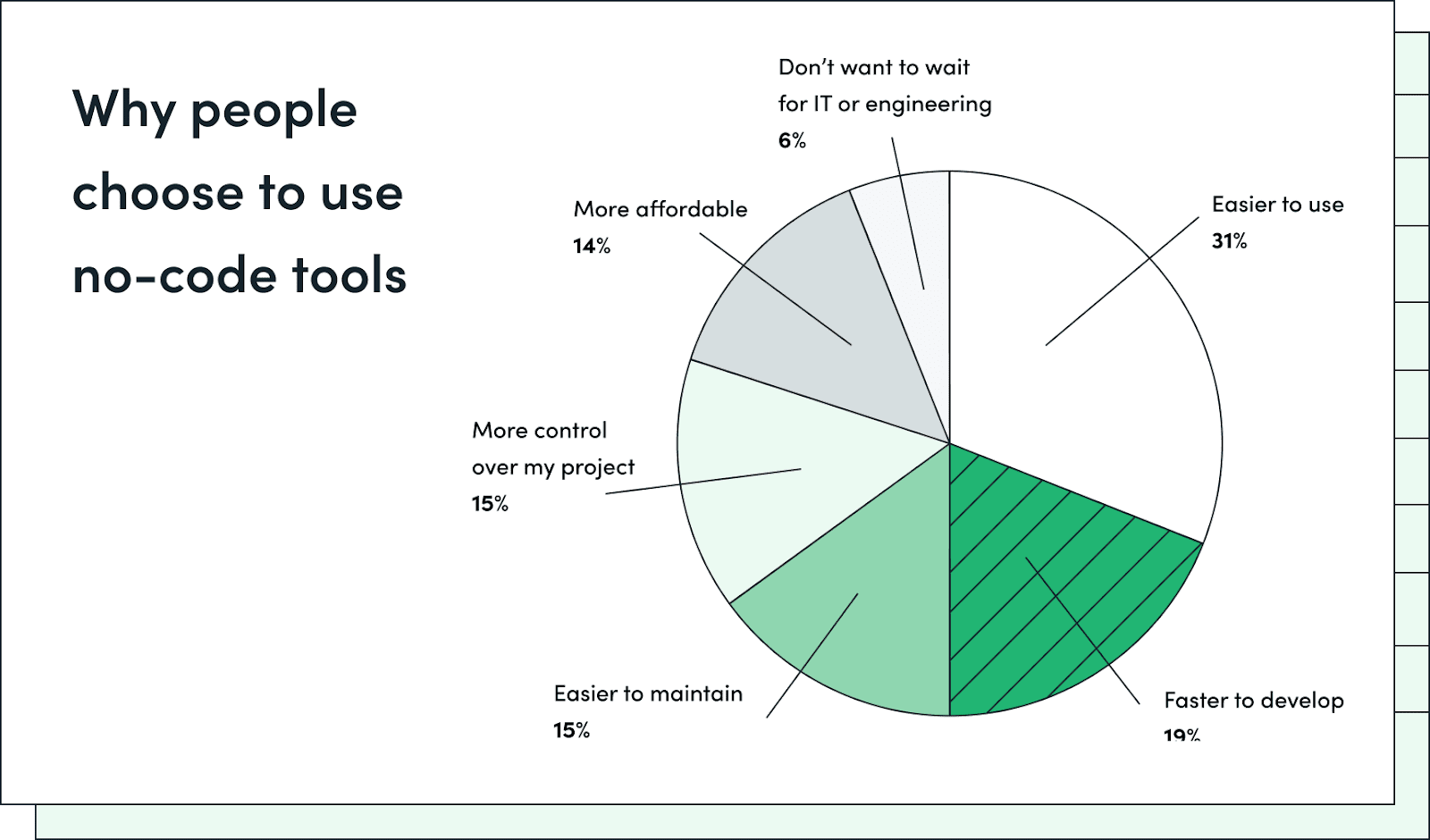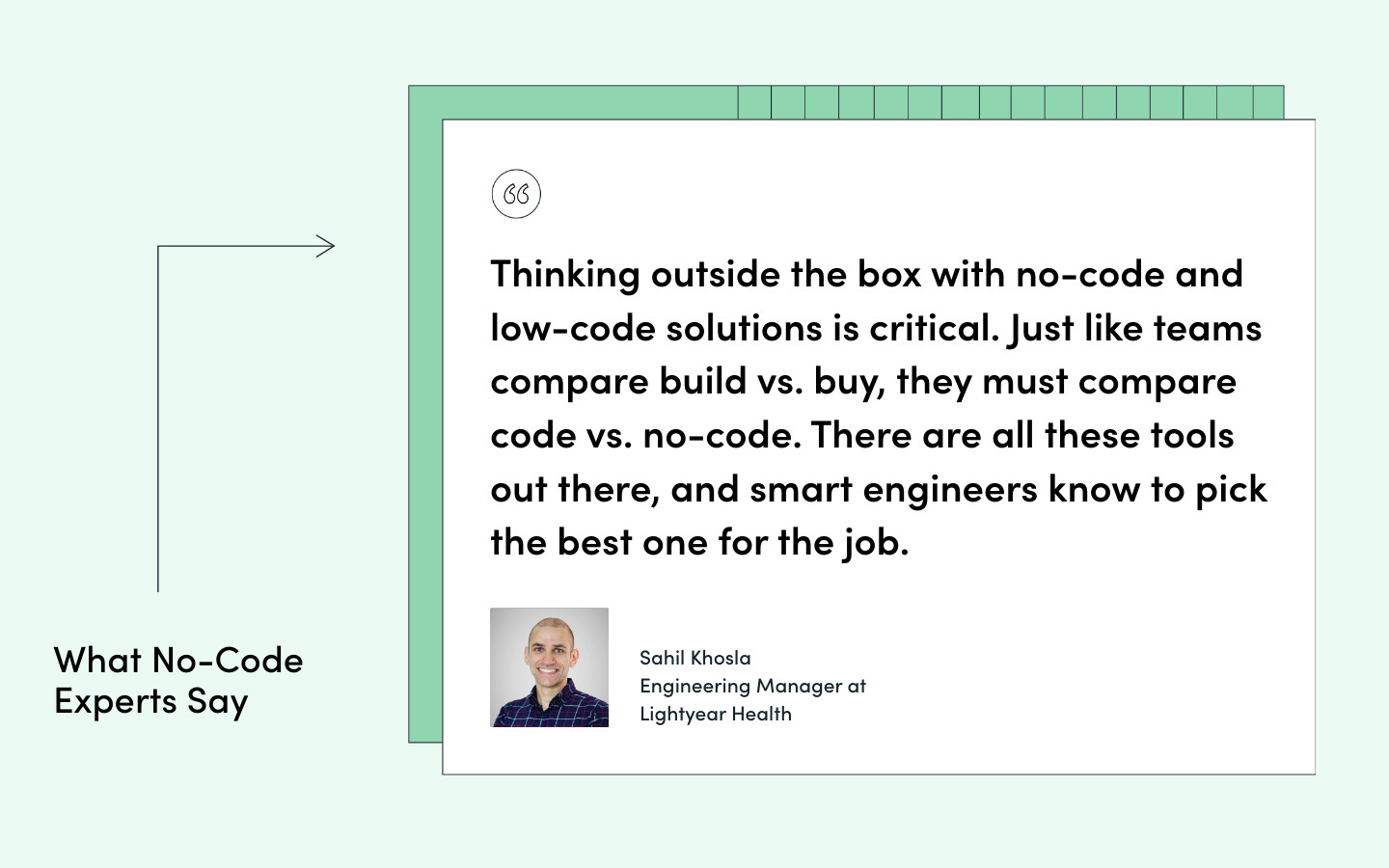Type “no-code developers” into Google.
Seriously, do it.
Once you hit enter, you may see the “People also ask” section pop up. As of February 2022, the top question in this section is will low-code replace developers?
If you continue down the Google rabbit hole, many articles pop up touching on this concern. You find a discussion on Quorra titled Will no code/low code replace software developers? There’s also a long thread at dev.to around the topic Will No-Code Replace Developers?
Built In’s article Will Low- and No-Code Platforms Steal Developers’ Jobs? dives deep into the question, and even Forbes covered it in the post Low-Code Versus No-Code And The Future Of Application Development.
The introduction of no-code and low-code technology is definitely a hot topic. So will no-code tools replace developers? Many sources agree that developers will never be replaced by no-code or low-code software.
But we want to take this conversation one step further and dive into why developers and IT teams should consider using no-code tools themselves. There’s a lot of talk about the citizen developer, but we want to shed light on how professional developers can benefit from no-code tools.
Speed Up Development Time
If you work on an engineering or IT team, you may feel like requests from other departments come in with short deadlines or marked as very high need. This can really throw a wrench into your workflows, especially when you’re in the trenches working on a crucial piece of a long-term, mission-critical project.
But for many teams, those smaller projects and requests made by other teams can’t just be put to the wayside. According to IDC, “the demographics of developers have already started to change such that developers are no longer defined by their proficiency in coding, but are rather defined by their ability to build digital solutions.”
Spinning up these digital solutions is key to overall business growth and success. With no-code tools, these projects can be spun up faster and easier, relieving some of the burden from software engineers.

“The learning curve for developers to pick up most no-code tools is literally nothing,” says Sahil Khosla, Engineering Manager at Lightyear Health and creator of the 30 Days Of No Code program. “I have tried almost 50 tools at this point, and there were only a handful where I had to refer to the docs or watch videos. Most of them were intuitive for me to figure out.”
Because no-code tools can be adopted quickly and easily, they can be a great solution for time or resource-strapped teams. “No-code offers coders a short cut of building a solution without the learning curve,” says John Elder, Director of The Business Blocks. “Speed to MVP is unparalleled when using no-code tools.”

Adding a few no-code tools to a dev team’s tech stack can help them support other teams without losing focus on their own work. But it also has the added value of making their own jobs easier by eliminating some of the need for manual coding work. Enabling them to spin up simple solutions quickly can ensure everyone’s needs are met without derailing larger projects or missing deadlines.
Mock Up MVPs Quickly
Creating an MVP is an incredibly important step in the development process. Yet creating one can be a very time consuming activity.
“With traditional coding, even an MVP becomes a huge undertaking, as there are many things to think about,” says Sahil. “Infrastructure, security, DevOps, and simply agreeing on an architecture or framework becomes a long discussion.”
These topics are important to the final product, but they can drag the process of spinning up an MVP on and on. Engineering teams don’t have months to spend on creating MVPs, especially when they may never lead to a final product. No-code tools can help by speeding up the process and making MVPs much easier to produce and review.
“The product team usually just wants to get something out of the door so they can start collecting feedback from customers. They rely on mock-ups to move fast,” says Sahil. “With no-code, they can actually have the engineering team build an MVP quickly or can even build it themselves.”
In fact, Formstack’s No-Code Economy Survey revealed that 38% of people chose no-code tools as a way to prototype a new idea or product. Of those surveyed, 56% know how to write code. This proves that many technical workers are choosing to add no-code tools into their workflows to improve the MVP process.

Communicate Easier With Other Teams
Coding includes many different languages, terms, and jargon, so it’s not surprising that software engineers and non-technical employees can have a hard time communicating.
“I think that for most non-technical folks, their ability to articulate exactly what they need from a developer is somewhat limited,” says Tara Reed, founder and CEO of Apps Without Code. “There's something that's lost in translation, whether that's the developer not understanding what they meant or they're using the wrong words with the developer. There's almost always a loss in communication.”
Tara points out that no-code tools can be used to create examples, providing both sides a visual to work off versus just an explanation of the needs and wants. This can minimize miscommunication and create better expectations of what teams are looking to create.
“Because we have no-code tools, you can just as quickly not only just get the visual, but get something that actually works and put it in front of people. You can then get two things–a visual and feedback,” she states.
In the Ripple Effect podcast episode Reimagining Work with No-Code Tools, Nile Frater, founder of NoCode.Tech, explains that no-code software empowers non-technical workers with a way to rethink processes, launch ideas, and solve problems alongside developers. “No-code is all about bridging the gap by essentially allowing more and more people in the business to prototype things and better communicate their ideas,” he says.
When developers add no-code tools into their tech stack that non-technical workers use as well, it opens up an entirely new way of communicating that can completely change the way projects are submitted, produced, reviewed, and put into production.

Make Time for Innovation
People who choose to go into software development oftentimes do so in order to create and innovate. But when software and engineering teams get bogged down by hundreds of requests and tedious system maintenance, the time available for innovating begins to disappear.
No-code can help these teams bring some of that innovation time back. As Sahil points out, “as developers and makers, we have many ideas but not enough time to execute on them. There are always things to be done and deadlines to be met. So no-code creates a unique opportunity to materialize those ideas.”
Free Up Developers
Thanks to no-code’s ease of use and speed, many IT and development teams who add no-code tools to their tech stack are able to free up a substantial amount of time. As Weblow points out, “Developers, and others with deeper technical backgrounds, are freed from the burden of writing huge amounts of code from scratch—allowing them to dedicate their time toward more sophisticated projects.”
When complicated technical systems can be replaced with no-code tools, there can be huge time savings. Freeing teams from having to maintain highly technical code improves their digital agility and allows them to move faster. This time can then be invested into new, innovative projects that have been consistently pushed down the priority list.

Sahil thoroughly understands how no-code can be a game-changer for dev teams. “Think of all the legacy systems that no one wants to touch because it’s a huge undertaking, and no one is ready to invest in upgrading them because of the cost. It’s tech-debt, and it literally slows the company down and prevents innovation,” he says.
“In those situations, thinking outside the box with no-code and low-code solutions is critical. Just like teams compare build vs. buy, they must compare code vs. no-code. There are all these tools out there, and smart engineers know to pick the best one for the job.”
Empower Other Teams
Oftentimes, departments must rely on IT teams to get most of their more technical work done. Our No-Code Economy survey found that a lack of technical resources results in 59% of projects being sometimes or often delayed. Many organizations don’t have the time or budget to invest in hiring more developers to solve this problem.
Did you know? Skilled software developers make up less than 1% of the working population.
So what can be done? According to Harvard Business Review, no-code tools can be the solution since they can help, “digitize and automate tasks and processes faster than trying to hire and onboard hard-to-source development talent.”
Minimizing the need to rely on coding enables many other teams to spin up exactly what they need, without putting in a request to IT or waiting on developer time to free up. Justin Torrence, founder of Jaybird Technologies, explains that, “applications can be rapidly built, deployed, and improved by users with very little training. This means as a person without coding skills, you could easily provide a tremendous amount of value to a business if they have a strong demand for custom tools.”

With no-code tools, departments outside of engineering or IT can build what they need, when they need it. Ideally, they would still have some access to technical workers as needed, but they could be nearly self-sufficient in many ways. “No-code promotes innovation at the grass root level within an organization. Employees in various departments such as HR, marketing, or even someone in finance can build solutions that meet exactly their needs and help them move a bit faster,” Sahil shares.
There may be times when code is required, which is why it’s important that technical workers also have access to the no-code tools used in other departments. But when implemented well, no-code can empower non-technical workers to innovate, be in control of their systems, and minimize reliance on IT.
“No-code tools are becoming more and more ubiquitous in every day,” says Justin. “Businesses are seeing the value in them and putting them in the hands of end users. I think it won’t be long before no-code tools are like a more resilient and governed version of spreadsheets.”
Empower Developers With No-Code Tools
If you’re looking to maximize the time and skills of the developers at your organization, consider investing in no-code tools. By adding just a few to your tech stack, you could speed up processes, reduce reliance on legacy technology, and empower all teams in your organization to be more productive.
The Rise of the No-Code Economy report revealed that 83% of people believe their use of no-code tools will increase in the next year. Will you join them?











